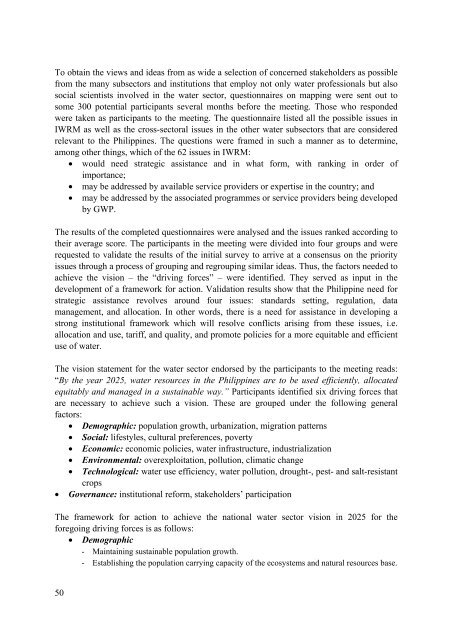The FAO-ESCAP pilot project on national water visions. From vision ...
The FAO-ESCAP pilot project on national water visions. From vision ...
The FAO-ESCAP pilot project on national water visions. From vision ...
Create successful ePaper yourself
Turn your PDF publications into a flip-book with our unique Google optimized e-Paper software.
To obtain the views and ideas from as wide a selecti<strong>on</strong> of c<strong>on</strong>cerned stakeholders as possible<br />
from the many subsectors and instituti<strong>on</strong>s that employ not <strong>on</strong>ly <strong>water</strong> professi<strong>on</strong>als but also<br />
social scientists involved in the <strong>water</strong> sector, questi<strong>on</strong>naires <strong>on</strong> mapping were sent out to<br />
some 300 potential participants several m<strong>on</strong>ths before the meeting. Those who resp<strong>on</strong>ded<br />
were taken as participants to the meeting. <str<strong>on</strong>g>The</str<strong>on</strong>g> questi<strong>on</strong>naire listed all the possible issues in<br />
IWRM as well as the cross-sectoral issues in the other <strong>water</strong> subsectors that are c<strong>on</strong>sidered<br />
relevant to the Philippines. <str<strong>on</strong>g>The</str<strong>on</strong>g> questi<strong>on</strong>s were framed in such a manner as to determine,<br />
am<strong>on</strong>g other things, which of the 62 issues in IWRM:<br />
• would need strategic assistance and in what form, with ranking in order of<br />
importance;<br />
• may be addressed by available service providers or expertise in the country; and<br />
• may be addressed by the associated programmes or service providers being developed<br />
by GWP.<br />
<str<strong>on</strong>g>The</str<strong>on</strong>g> results of the completed questi<strong>on</strong>naires were analysed and the issues ranked according to<br />
their average score. <str<strong>on</strong>g>The</str<strong>on</strong>g> participants in the meeting were divided into four groups and were<br />
requested to validate the results of the initial survey to arrive at a c<strong>on</strong>sensus <strong>on</strong> the priority<br />
issues through a process of grouping and regrouping similar ideas. Thus, the factors needed to<br />
achieve the visi<strong>on</strong> – the “driving forces” – were identified. <str<strong>on</strong>g>The</str<strong>on</strong>g>y served as input in the<br />
development of a framework for acti<strong>on</strong>. Validati<strong>on</strong> results show that the Philippine need for<br />
strategic assistance revolves around four issues: standards setting, regulati<strong>on</strong>, data<br />
management, and allocati<strong>on</strong>. In other words, there is a need for assistance in developing a<br />
str<strong>on</strong>g instituti<strong>on</strong>al framework which will resolve c<strong>on</strong>flicts arising from these issues, i.e.<br />
allocati<strong>on</strong> and use, tariff, and quality, and promote policies for a more equitable and efficient<br />
use of <strong>water</strong>.<br />
<str<strong>on</strong>g>The</str<strong>on</strong>g> visi<strong>on</strong> statement for the <strong>water</strong> sector endorsed by the participants to the meeting reads:<br />
“By the year 2025, <strong>water</strong> resources in the Philippines are to be used efficiently, allocated<br />
equitably and managed in a sustainable way.” Participants identified six driving forces that<br />
are necessary to achieve such a visi<strong>on</strong>. <str<strong>on</strong>g>The</str<strong>on</strong>g>se are grouped under the following general<br />
factors:<br />
• Demographic: populati<strong>on</strong> growth, urbanizati<strong>on</strong>, migrati<strong>on</strong> patterns<br />
• Social: lifestyles, cultural preferences, poverty<br />
• Ec<strong>on</strong>omic: ec<strong>on</strong>omic policies, <strong>water</strong> infrastructure, industrializati<strong>on</strong><br />
• Envir<strong>on</strong>mental: overexploitati<strong>on</strong>, polluti<strong>on</strong>, climatic change<br />
• Technological: <strong>water</strong> use efficiency, <strong>water</strong> polluti<strong>on</strong>, drought-, pest- and salt-resistant<br />
crops<br />
• Governance: instituti<strong>on</strong>al reform, stakeholders’ participati<strong>on</strong><br />
<str<strong>on</strong>g>The</str<strong>on</strong>g> framework for acti<strong>on</strong> to achieve the nati<strong>on</strong>al <strong>water</strong> sector visi<strong>on</strong> in 2025 for the<br />
foregoing driving forces is as follows:<br />
• Demographic<br />
- Maintaining sustainable populati<strong>on</strong> growth.<br />
- Establishing the populati<strong>on</strong> carrying capacity of the ecosystems and natural resources base.<br />
50
















